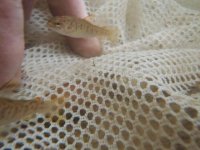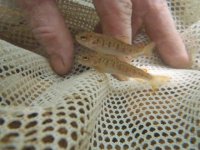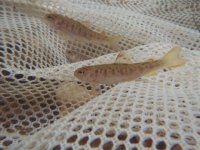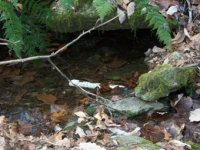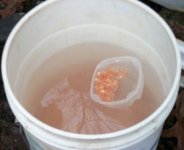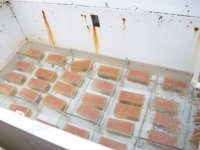Maurice
Administrator
Staff member
In October 2004 MCTU planted a short stretch of a tributary stream to the North Branch of Muddy Creek. This previously "mowed to the bank" step across stream section is just a short piece downstream from one of our streamside incubators where we hatch eyed brown trout eggs. These trout are the prodigy of two hatchery parents (brothers and sisters of the ones that come on the white trucks each spring). The difference is that these brown trout have to survive entirely on their own from foraging for food and finding suitable cover.
This stream is shallow, I mean 2-4" deep is a deep spot and for the first months of their lives it supplied cool clean water in the heat of summer and once they become larger they move downstream and ultimately into the North Branch of Muddy Creek.
We were really impressed with the success of the riparian project over the past 12 years and today we maintained it removing MF Rose and Honeysuckle vines, Virginia Creeper, etc. Then we went and seined the stream to see if we could find any of our babies.
Here they are. Alive and well and all the attributes of wild brown trout.
This is one of the examples to support my assertion that the Spot patterns and color focus to the lateral line spots is determined at a very early age. And once they reach an age where the spots are fixed and permanent, (in a nursery with fishmeal) they cannot ever look like this. Brown trout don't change their spots.
Enjoy.
This stream is shallow, I mean 2-4" deep is a deep spot and for the first months of their lives it supplied cool clean water in the heat of summer and once they become larger they move downstream and ultimately into the North Branch of Muddy Creek.
We were really impressed with the success of the riparian project over the past 12 years and today we maintained it removing MF Rose and Honeysuckle vines, Virginia Creeper, etc. Then we went and seined the stream to see if we could find any of our babies.
Here they are. Alive and well and all the attributes of wild brown trout.
This is one of the examples to support my assertion that the Spot patterns and color focus to the lateral line spots is determined at a very early age. And once they reach an age where the spots are fixed and permanent, (in a nursery with fishmeal) they cannot ever look like this. Brown trout don't change their spots.
Enjoy.


